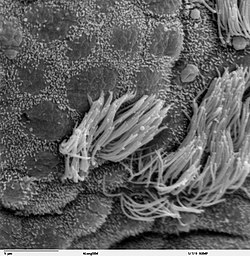
Back إزالة الغشاء المخاطي الهدبي Arabic Mukoziliäre Clearance German Clairance mucociliaire French Мукоцилиарный клиренс Russian
| Mucociliary clearance | |
|---|---|
 Ciliated epithelium in bronchus with short microvilli on non-ciliated cells | |
| Details | |
| System | Respiratory system |
| Identifiers | |
| MeSH | D009079 |
| Anatomical terminology | |
Mucociliary clearance (MCC), mucociliary transport, or the mucociliary escalator describes the self-clearing mechanism of the airways in the respiratory system.[1] It is one of the two protective processes for the lungs in removing inhaled particles including pathogens before they can reach the delicate tissue of the lungs. The other clearance mechanism is provided by the cough reflex.[2] Mucociliary clearance has a major role in pulmonary hygiene.
MCC effectiveness relies on the correct properties of the airway surface liquid produced, both of the periciliary sol layer and the overlying mucus gel layer, and of the number and quality of the cilia present in the lining of the airways.[3] An important factor is the rate of mucin secretion. The ion channels CFTR and ENaC work together to maintain the necessary hydration of the airway surface liquid.[4]
Any disturbance in the closely regulated functioning of the cilia can cause a disease. Disturbances in the structural formation of the cilia can cause a number of ciliopathies, notably primary ciliary dyskinesia.[5] Cigarette smoke exposure can cause shortening of the cilia.[6]
- ^ Antunes, MB; Cohen, NA (February 2007). "Mucociliary clearance--a critical upper airway host defense mechanism and methods of assessment". Current Opinion in Allergy and Clinical Immunology. 7 (1): 5–10. doi:10.1097/aci.0b013e3280114eef. PMID 17218804. S2CID 9551913.
- ^ Cite error: The named reference
Weinbergerwas invoked but never defined (see the help page). - ^ Widdicombe, J (October 2002). "Regulation of the depth and composition of airway surface liquid". Journal of Anatomy. 201 (4): 313–318. doi:10.1046/j.1469-7580.2002.00098.x. PMC 1570918. PMID 12430955.
- ^ Ghosh, A (October 2015). "Airway hydration and COPD". Cellular and Molecular Life Sciences. 72 (19): 3637–52. doi:10.1007/s00018-015-1946-7. PMC 4567929. PMID 26068443.
- ^ Horani, A; Ferkol, T (September 2018). "Advances in the Genetics of Primary Ciliary Dyskinesia: Clinical Implications". Chest. 154 (3): 645–652. doi:10.1016/j.chest.2018.05.007. PMC 6130327. PMID 29800551.
- ^ De Rose, V (April 2018). "Airway Epithelium Dysfunction in Cystic Fibrosis and COPD". Mediators of Inflammation. 8: 1309746. doi:10.1155/2018/1309746. PMC 5911336. PMID 29849481.
© MMXXIII Rich X Search. We shall prevail. All rights reserved. Rich X Search